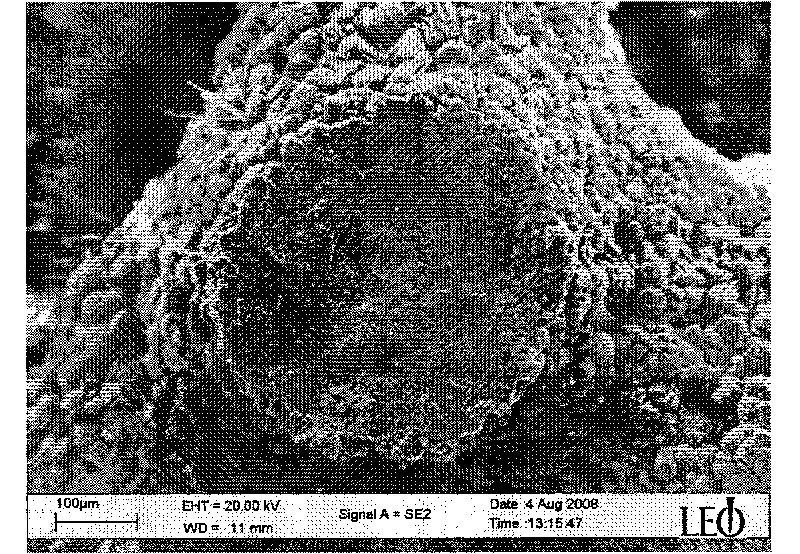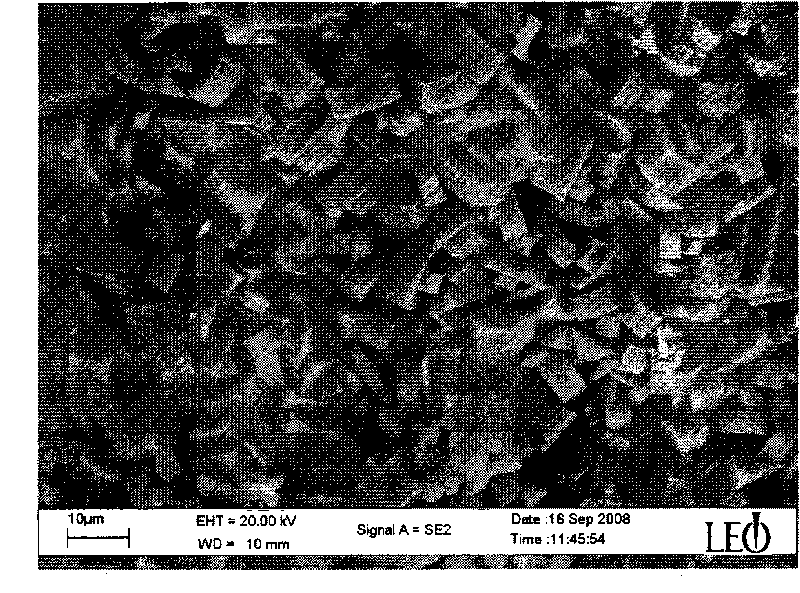Preparation method of molecular sieve coating material on surface of porous silicon carbide ceramic with surface rich in silicon
A technology of porous silicon carbide and silicon carbide ceramics, applied in chemical instruments and methods, molecular sieves and alkali exchange compounds, inorganic chemistry, etc., can solve the problems of molecular sieve layer shedding, increased side reactions, excessive metal carrier, etc., to achieve The effect of high interface bonding strength, change of grain size, and fast dissolution rate
- Summary
- Abstract
- Description
- Claims
- Application Information
AI Technical Summary
Problems solved by technology
Method used
Image
Examples
Embodiment 1
[0045] The preparation method of silicon-rich surface (the thickness of the silicon-rich layer on the surface of this embodiment is 3 microns) foamed silicon carbide ceramic surface silicalite-I molecular sieve coating material:
[0046] First, a hydrothermal synthesis solution is prepared, and tetrapropylammonium bromide, sodium hydroxide, and deionized water are mixed at a molar ratio of 0.1:0.6:100. The surface silicon-rich foam silicon carbide ceramics and silicon blocks (average particle size 800-1500 microns) are introduced into the reaction solution. The weight ratio of foam silicon carbide ceramic to the reaction solution is 1:20; the weight ratio of foam silicon carbide ceramic to solid silicon source The ratio is 1:0.5; the foamed silicon carbide ceramic is fixed 1 cm away from the bottom of the reactor with a polytetrafluoroethylene support frame, and the silicon block is placed at the bottom of the reactor; the volume of the solution is 50 ml, and the volume of the rea...
Embodiment 2
[0048] The preparation method of the ZSM-5 molecular sieve coating material on the surface of the silicon carbide foam ceramic surface is rich in silicon (the thickness of the silicon rich layer on the surface in this embodiment is 3 microns):
[0049] First, a hydrothermal synthesis solution is prepared, and tetrapropylammonium bromide, sodium hydroxide, and deionized water are mixed at a molar ratio of 0.1:0.8:100. The surface silicon-rich foamed silicon carbide ceramics, silicon-aluminum composite oxide sintered powder with a silicon-aluminum atomic ratio of 30:1 (on a 30-mesh sieve, in this embodiment, the silicon-aluminum composite oxide sintered powder has a silicon-aluminum atomic ratio The 30:1 ZSM-5 molecular sieve powder is granulated and molded, and then sintered at 1200°C for 1 hour) and silicon blocks (average particle size 2-3 mm) are introduced into the reaction solution, foam silicon carbide ceramics and the reaction solution The weight ratio is 1:20; the weight r...
Embodiment 3
[0051] The method for preparing the ZSM-11 molecular sieve coating material on the surface of the silicon carbide foam ceramic surface is rich in silicon (the thickness of the silicon rich layer on the surface in this embodiment is 3 microns):
[0052] First, prepare a hydrothermal synthesis solution, and mix tetrabutylammonium bromide, sodium hydroxide, and deionized water at a molar ratio of 0.1:0.8:100. The surface silicon-rich foamed silicon carbide ceramics and silicon-aluminum composite oxide sintered powder with a silicon-aluminum atomic ratio of 25:1 (average particle size 800-1500 microns, in this embodiment, the silicon-aluminum composite oxide sintered silicon-aluminum composite oxide The sintered powder is a ZSM-11 molecular sieve powder with a silicon-to-aluminum atomic ratio of 25:1, which is obtained after granulation, molding, and sintering at 1200°C for 1 hour.) The weight ratio of the foamed silicon carbide ceramic to the reaction solution It is 1:20; the weight...
PUM
| Property | Measurement | Unit |
|---|---|---|
| particle size | aaaaa | aaaaa |
| pore size | aaaaa | aaaaa |
| pore size | aaaaa | aaaaa |
Abstract
Description
Claims
Application Information
 Login to View More
Login to View More - R&D
- Intellectual Property
- Life Sciences
- Materials
- Tech Scout
- Unparalleled Data Quality
- Higher Quality Content
- 60% Fewer Hallucinations
Browse by: Latest US Patents, China's latest patents, Technical Efficacy Thesaurus, Application Domain, Technology Topic, Popular Technical Reports.
© 2025 PatSnap. All rights reserved.Legal|Privacy policy|Modern Slavery Act Transparency Statement|Sitemap|About US| Contact US: help@patsnap.com



